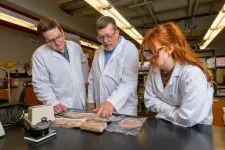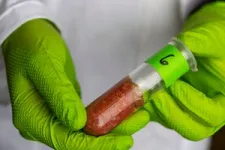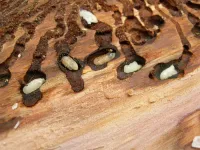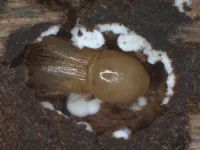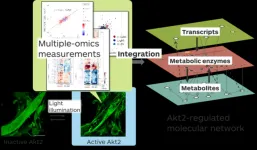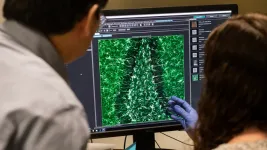(Press-News.org) Written by Kay Ledbetter, 806-547-0002, skledbetter@ag.tamu.edu
Imagine your favorite cured meat like beef jerky, pepperoni or bacon without any added sodium nitrite from any source currently necessary for color and shelf life. Wes Osburn, Ph.D., is doing exactly that.
At center, Wes Osburn, Ph.D., Texas A&M University meat scientist, is working in his lab with students Tanner Wright and Arlie Reeves on a new no nitrite-added cured meat system. (Texas A&M AgriLife photo by Michael Miller)
Osburn, associate professor in meat science in the Texas A&M College of Agriculture and Life Sciences Department of Animal Science, has set out to find an innovative method to generate the nitric oxide and residual nitrite needed to cure meat and poultry products, but without the addition of natural or synthetic nitrite sources.
Conventional curing of most processed meat products involves adding sodium nitrite to meat to preserve it and reduce the potential growth of bacteria like Clostridium botulinum or perfringens during cooking and chilling.
Curing meat
Osburn has been researching the idea of a novel amino acid alternative curing system for meat for many years. In 2022, he received a $500,000 U.S. Department of Agriculture–Agriculture and Food Research Initiative grant to determine the feasibility of adding amino acids to activate the nitric oxide synthase system.
Joining him in the research are Department of Animal Science faculty members Rhonda Miller, Ph.D., professor in meat science; Guoyao Wu, Ph.D., Distinguished Professor, University Faculty Fellow and Texas A&M AgriLife Research Faculty Fellow in animal nutrition; Sapna Chitlapilly Dass, Ph.D., assistant professor in microbial ecology and microbiome interactions; and Chris Kerth, Ph.D., associate professor in meat science; along with Ranjith Ramanathan, Ph.D., professor in meat science, Oklahoma State University.
Using naturally occurring nitrites and nitrates, a team led by Wes Osburn, Ph.D., Texas A&M University meat scientist, is working to make sure they can obtain the pink color of cured meats. (Texas A&M AgriLife photo by Michael Miller)
While curing meat with synthetic sodium nitrite is safe and efficient, the process has long been associated with cancer concerns. In response to these concerns, meat processors have developed “uncured” meat products that contain “no added nitrates or nitrites except those naturally occurring.”
This alternative curing system uses vegetable powder derived from celery as a natural source of nitrite to cure meat products. But these products may result in a detectable vegetable taste to the meat and a less favorable cured meat, or pink color, Osburn said.
Knowing that nitrites and nitrates occur naturally in humans and in some foods, Osburn believes it is possible to add an amino acid, L-arginine, to the meat that activates the nitric oxide synthase, NOS, enzyme contained in it. The NOS enzyme converts L-arginine to nitric oxide, NO, and another amino acid, L-citrulline.
The nitric oxide molecule creates the characteristic cured pink color associated with cured meats. Also, two nitric oxide molecules can combine to form nitrite, which serves as an antioxidant and antimicrobial to enhance product shelf life and safety.
Osburn said he was listening to a medical doctor friend, Dr. Nathan Bryan, speak about the endothelial nitric oxide synthase, eNOS, system in the human body and how it uses L-arginine to generate nitric oxide, which enhances circulation and blood flow. That is when the connection clicked, and he wondered if the eNOS enzyme could be activated by adding L-arginine to generate nitric oxide and cure meat.
“It could be that this approach is actually a ‘natural curing process’ by adding an amino acid to an enzyme whose primary function is to generate nitric oxide,” Osburn said. “I’m not adding any nitrates or nitrites.”
Utilizing natural amino acids
Osburn said adding the amino acid L-arginine will activate the nitric oxide synthase system to naturally generate nitric oxide and nitrite to cure meat and poultry products.
This novel amino acid-based alternative curing method is expected to eliminate the need for direct or indirect addition of sodium nitrite in cured meat products. Their research will allow for a better understanding of the interconnected biochemical mechanisms contributing to the functionality of the NOS system.
The research team plans to develop processing and operating procedures for meat processors to effectively use the NOS system to cure meat and poultry products consistently and predictably.
Osburn said they must validate the process’s feasibility and ensure it works, as well as make sure it works across species and products within species under all kinds of conditions. He said it will take a while to run the research on the different types of cured beef, pork and poultry products.
“There are differences in the amount of the NOS enzymes within different muscle groups across various meat species,” he said. “This enzyme is closely associated with the mitochondria, so there tends to be more NOS enzyme in muscles used for locomotion. There are also differences in myoglobin content (meat color pigment), so if we can generate nitric oxide via the NOS enzyme, the cured meat color may vary.
“That’s what we are trying to deal with, developing a uniform cured pink color via our amino acid-based curing system so that it compares favorably with conventionally cured meats.”
Where’s the meat?
“The question we are still trying to answer is will the NOS enzyme generate sufficient amounts of nitric oxide to develop acceptable cured meat color and enough residual nitrite to ensure that the product is safe, regardless of whether it is summer sausage or pepperoni or some other product?” Osburn said. “Think about it, if we can make pepperoni through this process, there could be a huge economic impact since we consume a lot of pepperoni here in the U.S.”
Cured meat products made without the addition of sodium nitrite are pictured at a lab of Wes Osburn, Ph.D., Texas A&M University meat scientist. (Texas A&M AgriLife photo by Michael Miller)
He said he is developing a prototype amino acid-cured ham product that will be taken through a manufacturing sensory analysis for cured color pigment, volatile compounds, sensory and textural analysis and shelf life.
His research team is manipulating several factors, such as the arginine concentration, meat pH, temperature and time to determine optimal conditions for nitric oxide generation by the eNOS enzyme.
“We are in the second phase of our USDA-NIFA-funded grant,” Osburn said. “We are shifting from benchtop to pilot plant production, so it is the first time we are making a commercial cured meat product and evaluating all aspects of the product from color, shelf life, aroma and sensory properties. This information will provide more evidence to show interested companies that this system works.”
His research team plans to apply this new curing system to five cured products – restructured ham, beef jerky, bacon, fermented summer sausage or salami and poultry frankfurters – all products requiring different processing steps to validate that the amino acid curing system effectively cures different meat products.
Moving to the cured meat case
“If, based on the results of our research, the data indicates that our new curing system is comparable to conventionally cured products with respect to safety, shelf life and sensory attributes, then there is a great chance for industry adoption of this process,” Osburn said. “This new curing system must compete favorably with the current curing system. If we can’t get close to it, it’ll always be a novel thing. Companies may or may not want to get on board.”
Osburn said while he is getting a lot of interest from meat companies in the process, there is still a lot of research to be done, as well as some upcoming rulings by the U.S. Department of Agriculture that will determine future labeling of current alternative or “uncured” meat products.
Robert Brummett, senior licensing manager at Texas A&M AgriLife Research’s Intellectual Property and Commercialization office, has worked with Osburn to seek intellectual property protection for the alternative meat curing process. A patent application was filed with the U.S. Patent and Trademark Office, USPTO, in December 2020.
According to Brummett, the patent application is currently being examined by the USPTO, and that process may take an additional 18 months or longer to complete. In the meantime, Osburn and Brummett are actively seeking interest from companies to license rights in the technology and/or working with Osburn in furthering the research for use of the technology by industry.
END
Texas A&M meat scientist developing ‘no nitrite-added’ cured meats
New technique would use an amino acid instead of sodium nitrite
2023-02-21
ELSE PRESS RELEASES FROM THIS DATE:
Conifer-killing beetles use smell of beneficial fungus to select host trees
2023-02-21
Eurasian spruce bark beetles (Ips typographus) burrow into the bark of Norway spruce (Picea abies) trees where they mate and lay their eggs. Major outbreaks in Europe have decimated millions of hectares of conifer forests. The beetles preferentially attack trees that are already infected with symbiotic fungi (such as Grosmannia penicillata), which is thought to weaken host trees and break down their chemical defenses, allowing the beetles to successfully develop in the bark.
To investigate the chemical signals ...
Symbiotic fungi transform terpenes from spruce resin into attractants for bark beetles
2023-02-21
The mass outbreaks of bark beetles observed in recent years have caused shocking amounts of forest damage throughout Germany. As reported by the Federal Statistical Office in July 2022, more than 80% of the trees that had to be felled in the previous year were damaged by insects. The damaged timber felled due to insect damage amounted to more than 40 million cubic meters. One of the main pests is the European spruce beetle Ips typographus. In the Thuringian Forest and the Harz Mountains, for example, the beetle, which is only a few millimeters long, encountered spruce monocultures that had already been weakened by high temperatures and extended ...
Shining light on an enzyme reveals its role in metabolism
2023-02-21
Takeaki Ozawa and his team from the University of Tokyo reveal the metabolic reactions upon activating an enzyme called Akt2. In doing so, they reveal the inner workings of insulin-regulated metabolism. The findings lead the way for Akt2-targeting therapeutics for diabetes and metabolic disorders.
It takes energy to do anything—even to exist. You can metabolize food to convert glucose into energy: thanks to many cascades of molecular reactions within your cells. As soon as you eat, your pancreas secretes insulin hormone, which starts ...
Impact of key Alzheimer’s protein depends on type of brain cell in which it is produced
2023-02-21
SAN FRANCISCO, CA—February 21, 2023—Of all the known genetic risk factors for late-onset Alzheimer’s disease, the strongest is a gene for the protein called ApoE4. People with one copy of this gene are 3.5 times more likely, on average, to develop Alzheimer’s than others, and those with two copies face a 12-fold increased risk. However, exactly how ApoE4 boosts the risk of Alzheimer’s remains unclear.
Multiple types of cells in the brain make ApoE4—some of it is produced by neurons, but other brain cells called glia make it in higher quantities. For that reason, most prior research on this protein has focused on ...
Douglas Rhoads named AAAS Fellow
2023-02-21
University Professor Douglas Rhoads has been named a Fellow of the American Association for the Advancement of Science, the world’s largest general scientific society and publisher of the journal Science.
As one of only 20 fellows representing the Section on Agriculture, Food & Renewable Resources, Rhoads was chosen by his peers and colleagues for advancing science and its applications in service to society. The organization elected a total of 505 fellows across 24 scientific sections.
Rhoads is director of the Interdisciplinary ...
Pill for skin disease also curbs excessive drinking
2023-02-21
Researchers from Oregon Health & Science University and institutions across the country have identified a pill used to treat a common skin disease as an “incredibly promising” treatment for alcohol use disorder.
The study was recently published in the Journal of Clinical Investigation.
On average, the people who received the medication, called apremilast, reduced their alcohol intake by more than half — from five drinks per day to two.
“I’ve never seen anything like that before,” said co-senior author Angela Ozburn, Ph.D., associate professor of behavioral neuroscience in the OHSU School of Medicine and a research biologist ...
University of Ottawa physician is first Canadian winner of new award focused on health workforce wellness
2023-02-21
The University of Ottawa's Dr. Mamta Gautam is the first awardee of the AFMC Wellness Award, a new national honour that recognizes an individual in Canada who has shown dedication to the promotion and advancement of the wellness of physicians, medical students, and others.
“I am truly humbled and honoured. Promoting physician wellbeing is an area that I have been passionate about for over 30 years. To have the AFMC create an award to recognize contributions in this area lends further credibility to the importance of this topic,” ...
Researchers discover mysterious source of 'heartbeat-like' radio bursts in a solar fare
2023-02-21
A solar radio burst with a signal pattern, akin to that of a heartbeat, has been pinpointed in the Sun’s atmosphere, according to a new study.
In findings published in the journal Nature Communications, an international team of researchers has reported uncovering the source location of a radio signal coming from within a C-class solar flare more than 5,000 kilometers above the Sun’s surface.
Researchers say the study’s findings could help scientists better understand the physical processes behind the energy release of solar flares — the solar system’s most powerful explosions.
“The ...
Three talented researchers recognized as endowed chairs
2023-02-21
Huntsman Cancer Institute at the University of Utah (The U) is pleased to congratulate three of our newest endowed chairs. A chair appointment recognizes excellence, while providing academic distinction and funding for future research. Alana Welm, PhD, received a five-year extension in her current role as Ralph E. and Willia T. Main Presidential Endowed Chair in Cancer Research, Aik Choon Tan, PhD, was named the Jon and Karen Huntsman Presidential Professor in Cancer Research, and Brad Cairns, PhD, was named ...
New transmitter design for small satellite constellations improves signal transmission
2023-02-21
Today, there are many emerging applications for small satellite constellations, ranging from space-borne networks to environmental monitoring. However, small satellites have special needs when it comes to transmitter (TX) technology. For one, they have stringent limitations on power consumption as they draw energy from solar panels and cannot easily dissipate generated heat. Moreover, small satellites need to communicate with fast-moving targets that can be over a thousand kilometers away. Thus, they require efficient and precise beam steering capabilities to direct most of the transmitted power ...
LAST 30 PRESS RELEASES:
Numbers in our sights affect how we perceive space
SIMJ announces global collaborative book project in commemoration of its 75th anniversary
Air pollution exposure and birth weight
Obstructive sleep apnea risk and mental health conditions among older adults
How talking slows eye movements behind the wheel
The Ceramic Society of Japan’s Oxoate Ceramics Research Association launches new international book project
Heart-brain connection: international study reveals the role of the vagus nerve in keeping the heart young
Researchers identify Rb1 as a predictive biomarker for a new therapeutic strategy in some breast cancers
Survey reveals ethical gaps slowing AI adoption in pediatric surgery
Stimulant ADHD medications work differently than thought
AI overestimates how smart people are, according to HSE economists
HSE researchers create genome-wide map of quadruplexes
Scientists boost cell "powerhouses" to burn more calories
Automatic label checking: The missing step in making reliable medical AI
Low daily alcohol intake linked to 50% heightened mouth cancer risk in India
American Meteorological Society announces Rick Spinrad as 2026 President-Elect
Biomass-based carbon capture spotlighted in newly released global climate webinar recording
Illuminating invisible nano pollutants: advanced bioimaging tracks the full journey of emerging nanoscale contaminants in living systems
How does age affect recovery from spinal cord injury?
Novel AI tool offers prognosis for patients with head and neck cancer
Fathers’ microplastic exposure tied to their children’s metabolic problems
Research validates laboratory model for studying high-grade serous ovarian cancer
SIR 2026 delivers transformative breakthroughs in minimally invasive medicine to improve patient care
Stem Cell Reports most downloaded papers of 2025 highlight the breadth and impact of stem cell research
Oxford-led study estimates NHS spends around 3% of its primary and secondary care budget on the health impacts of heat and cold in England
A researcher’s long quest leads to a smart composite breakthrough
Urban wild bees act as “microbial sensors” of city health.
New study finds where you live affects recovery after a hip fracture
Forecasting the impact of fully automated vehicle adoption on US road traffic injuries
Alcohol-related hospitalizations from 2016 to 2022
[Press-News.org] Texas A&M meat scientist developing ‘no nitrite-added’ cured meatsNew technique would use an amino acid instead of sodium nitrite
